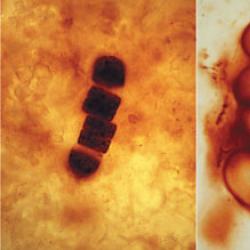Holothurians or sea cucumbers. Presentation on the topic "Echinoderms" Teacher mbou "Ust-Bakcharskaya sosh"
General characteristics Echinoderms are a type of exclusively marine bottom animals, mostly free-living, rarely sessile, found at any depth of the World Ocean. There are about 7,000 modern species (400 in Russia). Modern representatives of the phylum are sea stars, sea urchins, brittle stars (snaketails), holothurians (sea cucumbers) and sea lilies. This phylum also includes approximately extinct species that have flourished in the seas since the Early Cambrian.
Lifestyle They live exclusively on the seabed from the littoral zone (a section of the coast that is flooded with sea water during high tide and drained during low tide) and almost to extreme depths. At great depths, echinoderms, mainly holothurians, are the dominant group of bottom animals. They cannot tolerate changes in the salinity of water, as they are not able to regulate the salt composition of body fluids.


Starfish SEA STARS are one of the classes of echinoderms. Widely distributed marine animals, characterized by a five-rayed body shape with a warty or spinous surface. From the central disk of the starfish there are usually five (rarely up to 20 or more) rays, or arms, interlocking at wide bases.



Ambulacral system Echinoderms have a special locomotion system. A network of vessels stretching along the rays communicates with the external environment through pores. It is filled with a liquid similar to sea water and is called ambulacral. Short outgrowths extend from it - ambulacral legs. They can be seen on the oral side of the body. Alternately sucking on them, the animal moves quite quickly along the sand or stone.

Ambulacral system The starfish moves thanks to the presence of an ambulacral system (blue in the picture), which is a unique feature of echinoderms. Water enters through the filter plate (1)… …and, due to the movement of tiny hairs, is distributed throughout all five radial channels, to which are connected many pairs of legs (2), equipped with suction cups. When the ampoule (3) of each such leg is compressed, water is pumped into the leg tube (the figure shows a cross section), and the leg bends in the direction of movement (4), due to which the star is attached to the surface of various underwater objects. Then the muscles of the leg contract (5), water fills the ampoule again, and due to this the animal moves forward.




This is interesting! Starfish develop a voluminous stomach that can be turned inside out through the mouth. The star envelops prey that it cannot swallow with its stomach, and thus carries out external digestion. A starfish can open the shell of a bivalve mollusk and digest it right in it.

Sea Urchins The body of sea urchins is usually almost spherical, ranging in size from 23 to 30 cm; covered with rows of limestone plates. The plates, as a rule, are connected motionlessly and form a dense shell (shell), which does not allow the hedgehog to change shape. Based on body shape (and some other characteristics), sea urchins are divided into regular and irregular. Regular hedgehogs have an almost round body shape, and they are built according to strictly radial five-ray symmetry. Irregular hedgehogs have a flattened body shape, and the anterior and posterior ends of the body are distinguishable.


Interesting animal! Flat sea urchin Lives everywhere from the coastal zone to a depth of 150 m, although it is most often found at a depth of 612 m. It prefers sandy soils, into which it burrows completely with the help of needles in about 10 minutes. The number of sand dollars in the coastal waters of the Far Eastern seas is so great that in some areas they literally cover the sandy bottom with a continuous “pavement.”


Holothurians Holothurians differ from other echinoderms by their oblong, worm-like, less often spherical shape, the absence of protruding spines and the reduction of the dermal skeleton to small calcareous “bones” located in the body wall. The five-ray symmetry of the body in holothurians is masked by the bilateral arrangement of many organs.



Economic importance Some species of sea cucumbers, especially from the genera Stychopus and Cucumaria, are eaten under the name “sea cucumbers”. Their fishing is most developed off the coast of Japan, China, the Malay Archipelago and in the South Pacific Ocean. Holothurian fishing is also carried out in the Russian Far East. Toxins produced by sea cucumbers are of pharmacological interest. Fishermen on the Pacific Islands use poisonous Cuvier's tubules of some species when fishing.



Sea lilies Sea lilies are the only echinoderms that have retained the body orientation characteristic of the ancestors of echinoderms: their mouth is turned upward, and their dorsal side is turned towards the surface of the ground. Like all echinoderms, the body structure of crinoids is subject to five-ray radial symmetry. The loose corolla of the sea lily forms a net to trap plankton and detritus.



Lifestyle Stemled crinoids (about 80 species) lead a sessile lifestyle and are found at depths from 200 to 9700 m. Stemless crinoids (about 540 species), are most diverse in the shallow waters of tropical seas, often brightly and variegatedly colored. Approximately 65% of stemless crinoids live at depths of less than 200 m. In the tropical Pacific Ocean, up to 50 species can live on one reef. Stemless lilies are able to detach from the substrate, move along the bottom and float up due to the movement of their hands.

Brittle stars Externally similar to starfish. The body consists of a flat central disk and 5 (rarely 10) flexible long arms, or rays, extending from it. Disc diameter no more than 10 cm; the arms reach a length of 60 cm. The rays of ophiuroids are articulated and consist of many internal “vertebrae” driven by intervertebral muscles. They do not contain processes of internal organs. In most species, the arms are movable, mainly in the horizontal plane.

Type Echinoderms.
Teacher MBOU "Ust-Bakcharskaya secondary school"
Kovaleva Yu.D.

Lesson plan.
- General characteristics.
- Class Sea lilies.
- Class Starfish.
- Class Sea urchins.
- Ophiura class.

General characteristics.
- The phylum Echinodermata, numbering more than 6,500 species, includes animals that live in the seas and oceans, both at great depths and in shallow waters.
- The body of echinoderms, from 5 mm to 5 m long, has ray (radial) symmetry, a calcareous skeleton, often with numerous needles and spines. All echinoderms have water-vascular system, with the help of which they can move, and representatives of some species can touch and even breathe.

- Slow movement along the bottom is carried out when the legs - tubes, often with suction cups at the ends - are filled with liquid.
- The body shape of echinoderms is very diverse.
- There is no division of the body into sections.
- Echinoderms are usually dioecious. They have a high ability to regenerate.

Class Sea lilies.
Among crinoids there are sessile and
free-floating forms. The mouth opening of these echinoderms opens in the upper part of the body. All crinoids feed on small planktonic organisms. Breathe the surface of the body. There are usually 5 tentacles, but they can branch up to 200 or more processes.


Class Starfish.
- These are sedentary animals with from 5 to 50 rays. Their mouth opening is on the underside of the body. Starfish feed mainly on dead animals, as well as mud and sedentary animals. Some predatory starfish destroy commercial shellfish. The stomach of these echinoderms can evert out through the mouth opening and envelop the prey.
- Among sea stars there are both hermaphrodites and dioecious ones. Reproduction is asexual and sexual. The fertility of sea stars can vary: per individual from several tens to 200 million. eggs
- In the shallow waters of the northern seas, starfish freeze in winter. And in the spring they thaw.


Class Sea urchins.
- Free-living animals with a hard shell covered with movable spines. Representatives of some species can use them to move along the bottom. The mouth is equipped with a gnawing apparatus and is located on the underside of the body. They feed on algae, sessile animals, and mud. One female lays up to 20 million eggs.


Class Holothuria, or Sea Cucumbers.
- The body of these animals shrinks greatly when touched and becomes like a cucumber. Related to holothurians sea cucumbers They are edible, they are caught and even specially bred. The body length of holothurians usually ranges from several mm to 2 m. The mouth is located at the anterior end of the elongated body. Holothurians feed mainly on animals living on the surface of silt, plants and their remains.
- Almost all sea cucumbers are dioecious, but hermaphrodites are also found. Some species of these echinoderms show care for their offspring. One female lays up to 77 million eggs.



Ophiura class.
- Flat, freely moving echinoderms, up to 10 cm in diameter and with long, sometimes branching rays. Brittle stars move by lifting their body above the ground with the help of rays. By extending branched rays, brittle stars catch and capture small planktonic organisms, filtering the water.
- Brittle stars are dioecious, but some are hermaphrodites and reproduce asexually.
- There are brittle stars living on other echinoderms, as well as on sponges and corals. Some of the brittle stars can glow. Many have developed the ability to regenerate.

Type Echinoderms 7th grade Teacher: Tipikina T.I.
General characteristics Echinoderms are the most ancient groups that had bilateral body symmetry. Then they switched to a sedentary, and some to an attached, lifestyle, and in connection with this, the symmetry of adult forms became five-rayed, but their larvae retained bilateral symmetry. Modern classes of the type include: sea lilies, starfish, brittle stars, sea urchins and sea cucumbers. Currently, there are about 6,500 species. They live in the seas, oceans, both at great depths and in shallow waters
Echinoderms The mouth of echinoderms is located on the oral side of the body. The anus is most often located on the aboral side, but in crinoids and irregular sea urchins it is located on the oral side of the body. The digestive tube is represented by a long intestine. Starfish develop a voluminous stomach that can be turned inside out through the mouth.
Nervous system The nervous system of echinoderms is primitive, consisting of three separate parts, built according to a radial plan: the nerve ring and radial nerve cords.
Class Starfish Starfish are exclusively marine animals and are not found in fresh water bodies. About 150 species live in the Russian seas. All sea stars as adults lead a bottom-dwelling lifestyle, crawling along the surface of the bottom or burrowing into the ground. Many of the sea stars are active predators. Mud-eaters predominate among deep-sea starfish - they use sea soil for food, extracting organic matter from it. Some starfish can eat plankton. Most starfish detect prey and determine its location thanks to substances that the prey releases into the water.
Hermaphrodites and dioecious. Reproduction is sexual and asexual. Asexual. Some starfish reproduce regeneratively. In their body, the connective tissue softens and they break up into several parts, usually two. Soon independent starfish will grow from these parts. Sexual. Reproduction is carried out by fertilization of the female's eggs with the reproductive products of the males, which are hatched directly into sea water. A female starfish can lay several million eggs at a time.
Class Sea lilies Bottom animals with a body in the form of a cup, in the center of which there is a mouth, and a corolla of branching rays extends upward. Lead si. active lifestyle and are found at depths from 200 to 9700 m. All sea lilies are passive filter feeders, filtering a nutrient suspension from the water: protozoa (diatoms, foraminifera), invertebrate larvae, small crustaceans.
Reproduction Dioecious; gametes develop in pinnules. Development with a floating larva The larvae, attaching to the substrate, turn into a miniature stem like an adult lily. In stemless lilies, the stem dies off as it grows into an adult form.
Class Sea urchins Free-living. Sea urchins are bottom crawling or burrowing animals. The body of sea urchins is usually almost spherical, ranging in size from 2-3 to 30 cm; covered with rows of limestone plates. The plates, as a rule, are connected motionlessly and form a dense shell (shell), which does not allow the hedgehog to change shape.
Almost omnivorous. The diet includes algae, sponges, bryozoans, ascidians and a variety of carrion, as well as mollusks, small starfish and even other sea urchins
Sea urchins are dioecious. Development with planktonic larva (Echinoplutheus); Some Antarctic species are viviparous - the eggs develop under the protection of spines on the upper side of the body or in the brood chamber, so that the young hedgehog leaves the mother fully formed. Urchins reach sexual maturity and commercial size in the third year of life.
Class Holothurians or Sea Cucumbers Species eaten as food are collectively called "sea cucumbers".
Holothurians are sedentary or crawling animals, distinguished by their oblong, worm-like, less often spherical shape, the absence of protruding spines and the reduction of the skin skeleton to small calcareous “bones” located in the body wall. They live in the seas at various depths
Reproduction Dioecious, some are hermaphrodites. The reproductive organ (gonad) is unpaired, in the form of a bundle of finger-shaped tubes. Fertilization of the egg and development of the embryo in most species is external. Some holothurians catch eggs with tentacles and attach them to the dorsal side of the body; in rare cases, embryos develop in a body cavity. Holothurians develop with metamorphosis: floating larvae emerge from the eggs. The initial form of the larva, as in all echinoderms, is represented by a dipleurula; after three days it turns into auricularia and then into doliolaria.
Protection By contracting strongly, sea cucumbers eject their entrails through the anus, which are subsequently restored
Class Brittle stars Brittle stars live on the seabed everywhere, at a depth of 6-8 km. Most are found at depths greater than 500 m; They also inhabit coral reefs. They crawl along the bottom by bending their rays or burrow into the ground. They move in jerks, stretching 2 pairs of arms forward and sharply bending them back. When feeding, the arms of brittle stars rise almost vertically upward. Some brittle stars have branched arms
Diet By nature of feeding, brittle stars are mucociliary filter feeders; There are also brittle stars - detritivores and carrion eaters.
Brittle stars have a developed ability to regenerate rays, but if all the rays are cut off from the disk, the animal will die. Brittle stars often form mass settlements and serve as food for fish. Some brittle stars live on algae, sponges, corals and sea urchins.
Reproduction and development Brittle stars are usually dioecious, but there are also hermaphrodite species. Only a few are able to reproduce asexually - by dividing into two, with the subsequent restoration of the missing parts. Development occurs in most cases with metamorphosis, with the formation of a free-swimming larva - ophiopluteus. Less often, direct development
Slide 2
Scientific classification
- Starfish class
- Ophiura class (Snaketails)
- Class Sea cucumbers (Holothurians)
- Class Sea lilies
- Class Sea urchins
Slide 3
Characteristic
- All echinoderms are marine animals that live only in salt water.
- Today there are about 7 thousand modern species (of which 400 are in Russia).
Slide 4
Fossil echinoderms
- The first to appear in the Ordovician period and became the ancestors of all echinoderms were crinoids.
- The remains of echinoderms are still found today. Thanks to their calcareous skeleton, echinoderms are well preserved in fossil form.
Slide 6
Echinoderms have the ability to regenerate - restore lost body parts
Slide 7
Sea stars
- The shape resembles a five-rayed star, but there are species that can have eight rays, and sometimes 16 or 50.
- Currently, about 1.5 thousand species are known, living mainly in tropical seas.
Slide 8
- All starfish are predators. They feed on: shellfish, soft corals and sea urchins.
- From the underside of each ray are rows of tiny tube feet with a suction cup at the end. Handling them, the animal slowly crawls along the bottom and rises to vertical surfaces.
Slide 9
Sea urchins
Sea urchins are bottom dwellers. The body of sea urchins is almost spherical or ovoid. The outside is covered with rows of calcareous plates, spines or needles. The plates, as a rule, are connected motionlessly and form a dense shell (shell), which does not allow the hedgehog to change shape.
Slide 10
- They live in algae thickets, on rocks, on coral reefs, on the ground and even in the ground.
- Some feed on mollusks, while others, scraping algae from stones, have a mouth with a special chewing apparatus resembling a drill. With its help, some sea urchins not only feed, but can also drill holes in rocks.
Slide 11
Brittle stars (snaketails)
- The body is star-shaped, consisting of a flat disk and 5 rays.
- They form mass accumulations; some species settle on corals, sponges, and algae.
Slide 12
- They mainly feed on small animals, but there are species that feed on dead remains.
- They move by bending their rays.






